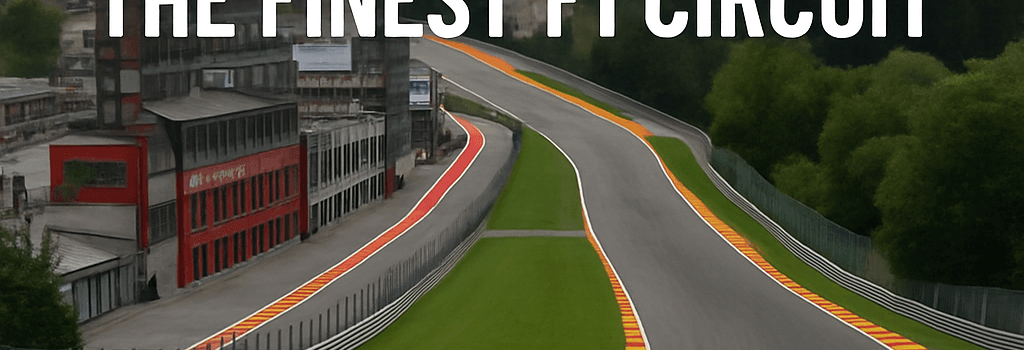Inside Spa-Francorchamps: The Finest F1 Circuit

Historic Heritage and Modern Evolution
Spa-Francorchamps has been a cornerstone of grand prix motor racing since 1920. The current 7.004 km layout features 19 turns, 102 m of elevation change, and average lap speeds exceeding 240 km/h. Originally run on public roads linking Francorchamps, Malmedy and Stavelot, the circuit was shortened in 1979 for safety: gravel traps, TecPro barriers and extended run-offs now line high-speed sections.
Track Layout Highlights
- La Source: Heavy braking zone—312 km/h to 80 km/h in 150 m, generating peak deceleration of 5.5 g.
- Eau Rouge & Raidillon: 2nd-gear uphill left-right-left featuring 18 % gradient, challenging chassis pitch control and suspension travel.
- Pouhon: 180-degree right-hander at 280 km/h—tests lateral aero balance and tyre thermal management.
- Bruxelles & Blanchimont: Quick flicks at up to 330 km/h, demanding precise aerodynamic load and minimal ride harshness.
Sprint Weekend and Technical Upgrades
In 2025, Spa hosted a sprint weekend under the revised FIA regulations. Teams brought major aerodynamic updates—larger floor edge fences, modified beam wings, and revised brake duct cooling. A typical RB21 update trimmed 0.3 s per lap at high speed whilst adding 1 % downforce. Mercedes experimented with dual-axis steering (DAS) software tweaks, while Ferrari installed 2026 hybrid ERS cooling loops for improved power unit reliability.
Sprint Qualifying Dynamics
- Track Evolution: As rubber built up, grip levels rose by 12 %, highlighting the importance of warm-up laps.
- Gabriel Bortoleto: The Sauber rookie broke into SQ3 using optimized camber and toe settings—0.8° front camber delivering 2 % extra mechanical grip.
- Team Principal Change: Laurent Miekes’s appointment at Red Bull triggered a shift toward drivability over peak performance; aerodynamicist Adrian Newey confirmed a stiffer front wing section for 2025 upgrades.
Race Day: Weather Modeling and Strategy
Spa’s microclimate is famed for rapid weather shifts. On race morning, rain-radar models predicted 15 mm of precipitation over one hour. Teams ran bespoke software from CoolTech Analytics ingesting local lidar and Doppler data to optimize pit-stop windows. Drivers toggled between intermediate grooved and full-wet tires, each with 8 mm vs. 6 mm tread depths, respectively.
Ross Brawn: “Spa remains the ultimate test—drivers need mechanical precision and adaptive strategy against unpredictable weather. Our simulations still miss sudden cloudbursts.”
Technical Insights: Aerodynamics and Car Setup
Setting up for Spa requires a compromise: low drag for the Kemmel Straight (1.2 km) versus downforce for the rapid corners. Typical downforce target is 750 kg at 300 km/h. Suspension stiffness runs at 70 Nm/deg front and 65 Nm/deg rear, balancing pitch control through Eau Rouge.
- Wing Configurations: Front wing angles around 10°, rear wing DRS gap at 85 mm maximum.
- Brake Cooling: Carbon-ceramic discs run at 1 200 °C peak; duct inlets increased by 5 % aperture for 2025’s cooler ambient temperatures.
- Power Unit Modes: ERS deploy rates capped at 65 kW continuous, with MGU-K and MGU-H algorithms tuned to harvest extra energy on braking zones.
Track Evolution and Safety Upgrades
Since its inception, Spa has evolved with FIA Grade 1 standards. The 2024 resurfacing project introduced porous asphalt for improved drainage—reducing aquaplaning risk by 20 %. Gravel traps were replaced with FIA’s eco-sand at Raidillon, enhancing deceleration by 0.4 g over conventional gravel beds.
Historical Evolution and Future Outlook
The Ardennes layout has witnessed iconic moments: Fangio’s 1953 uphill pass, Senna’s 1985 debut lap record, and Hakkinen’s 1998 wet-wet duel. Looking forward, proposed 2026 power unit regulations (65 % electrical energy) will emphasize battery cooling and inverter packaging near the rear subframe. Architect Christian von Koenigsegg has consulted on potential modular pit lane expansions to support longer sprint formats.
Conclusion
Though the 2025 Belgian Grand Prix lacked rain-soaked wheel-to-wheel duels, Spa-Francorchamps remains unmatched in complexity. From its rich history to cutting-edge technical demands—elevation, aerodynamics, weather unpredictability—Spa is the benchmark for Formula 1 and endurance racing alike. Plan a visit: the 6-hour WEC race in May offers deeper paddock access at a fraction of F1 ticket prices.